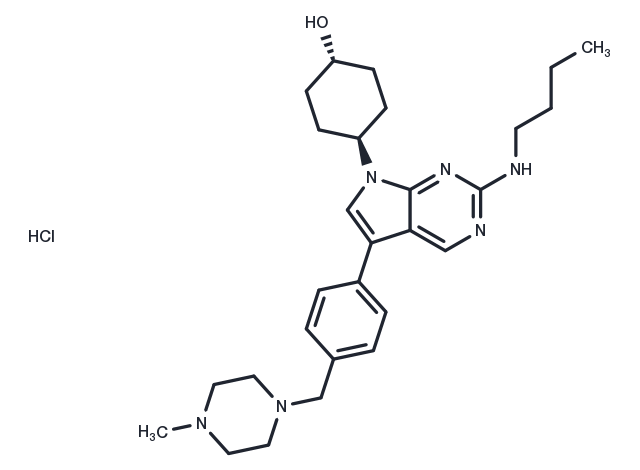Powder: -20°C for 3 years | In solvent: -80°C for 1 year


UNC2025 hydrochloride is a potent, ATP-competitive, highly orally active Mer/Flt3 inhibitor. It has IC50 values of 0.74 nM and 0.8 nM, respectively, for Mer and Flt3. UNC2025 hydrochloride demonstrates over 45-fold selectivity for MERTK compared to Axl (IC50 = 122 nM; Ki = 13.3 nM). Additionally, UNC2025 hydrochloride exhibits excellent PK properties, making it suitable for investigating acute leukemia.

| Description | UNC2025 hydrochloride is a potent, ATP-competitive, highly orally active Mer/Flt3 inhibitor. It has IC50 values of 0.74 nM and 0.8 nM, respectively, for Mer and Flt3. UNC2025 hydrochloride demonstrates over 45-fold selectivity for MERTK compared to Axl (IC50 = 122 nM; Ki = 13.3 nM). Additionally, UNC2025 hydrochloride exhibits excellent PK properties, making it suitable for investigating acute leukemia. |
| Targets&IC50 | FLT3:0.8 nM (IC50), Mer:0.74 nM (IC50) |
| In vitro | UNC2025 exhibits targeted activity against multiple kinases, including FLT3, MER, AXL, TRKA, TRKC, QIK, TYRO3, SLK, NuaK1, KIT, and Met, with respective IC50 values of 0.35 nM, 0.46 nM, 1.65 nM, 1.67 nM, 4.38 nM, 5.75 nM, 5.83 nM, 6.14 nM, 7.97 nM, 8.18 nM, and 364 nM. In 697 B-ALL cells, a 1-hour exposure to UNC2025 between 0-60 nM effectively inhibits Mer phosphorylation with an IC50 of 2.7 nM, and similarly decreases Flt3 phosphorylation in Flt3-ITD positive Molm-14 acute myeloid leukemia cells with an IC50 of 14 nM. Furthermore, concentrations ranging from 3 nM to 3 μM lead to reduced p-MEK, p-AXL, and p-TYRO3 expression in 32D Cells in a concentration-dependent manner. Extended treatment (14 nM–10 μM for 48 hours) suppresses MERTK signaling and the colony-forming capability in MERTK-expressing patient samples, showing a 20-fold higher sensitivity in leukemia blasts compared to normal cord or marrow blood mononuclear cells. Dose-dependent decreases in MERTK phosphorylation/activation, along with diminished phosphorylation of STAT6, AKT, and ERK1/2, were observed in both cell lines and patient samples, indicating effective inhibition of MERTK-dependent signaling pathways. This comprehensive action of UNC2025, demonstrated through various assays, highlights its significant potential in targeted cancer therapy. |
| In vivo | UNC2025, administered either through intravenous injection or orally at a dose of 3 mg/kg, demonstrates exceptional pharmacokinetic (PK) properties, including low clearance (9.2 mL/min kg), a longer half-life (3.8 h), and complete oral bioavailability (100%). Pharmacokinetic parameters such as the time to maximum concentration (Tmax), maximum concentration (Cmax), and area under the curve to the last measurable concentration (AUClast) were observed at 0.50 hour, 1.6 μM, and 9.2 h⋅μM, respectively. Furthermore, when administered orally at doses of 50 or 75 mg/kg for 34 and 70 days, respectively, UNC2025 significantly reduces tumor burden in a dose-dependent manner compared to the control and prolongs median survival from 26 days in control-treated mice to 34 and 70 days for mice treated with 50 or 75 mg/kg, respectively. These outcomes were observed in NSG mice injected with 697 B-ALL cells, indicating that UNC2025 delays disease progression through oral administration. |
| Synonyms | UNC2025 hydrochloride |
| Molecular Weight | 513.13 |
| Formula | C28H41ClN6O |
| CAS No. | 2070015-17-5 |
Powder: -20°C for 3 years | In solvent: -80°C for 1 year
You can also refer to dose conversion for different animals. More
bottom
Please see Inhibitor Handling Instructions for more frequently ask questions. Topics include: how to prepare stock solutions, how to store products, and cautions on cell-based assays & animal experiments, etc.
UNC2025 hydrochloride 2070015-17-5 UNC-2025 hydrochloride UNC 2025 Hydrochloride UNC2025 Hydrochloride UNC-2025 Hydrochloride inhibitor inhibit
